Total Weight:
57.8 lbs (26.21 kg)
(Step-Thru 58.5, High-Step 57.5)Battery Weight:
5.6 lbs (2.54 kg)
Motor Weight:
8.8 lbs (3.99 kg)
Frame Material:
6061-T6 Aluminum Alloy
Frame Sizes:
19 in (48.26 cm)20.5 in (52.07 cm)Geometry Measurements:
Men’s High-Step Measurements: 20.5" Seat Tube, 24.25" Reach, 29.5" Stand Over Height, 29.5" Width, 76.5" Length, Women’s Step-Thru Measurements: 19” Seat Tube, 24” Reach, 21” Stand Over Height, 29.5” Width, 76.5” Length
Frame Types:
High-Step, Step-Thru
Frame Colors:
Satin Black, Stone Grey, Black, Mineral Blue
Frame Fork Details:
Hi-Ten Steel Unicrown, Straight Tapered Leg, 100 mm Hub Length, 10 mm Axle with Nuts
Frame Rear Details:
135 mm Hub Length, 10 mm Axle with Nuts
Attachment Points:
Rear Rack Bosses, Fender Bosses
Gearing Details:
8
Speed 1x8 Shimano Nexus Inter-8 Internally Geared HubShifter Details:
Shimano Nexus 8-Speed Grip Twist
Cranks:
FSA Forged Alloy, 170 mm Length, 20 Tooth Chainring
Pedals:
VP Alloy Platform wtih Non-Slip Rubber Tread
Headset:
1-1/8" Steel Threaded, Semi-Integrated
Stem:
Forged Alloy, 25.4 mm Quill, 80 mm Extension
Handlebar:
Alloy Custom Bend, 24.8" Width, 3.5" Rise
Brake Details:
Tektro Auriga Hydraulic Disc with 180 mm Front Rotor and 160 mm Rear Rotor, Tektro Auriga Two-Finger Levers with Reach Adjust
Grips:
Ergo-Shaped Hand-Stitched Leatherette
Saddle:
Electra Branded Velo, Ergonomic with Shock-Absorbing Elastomers
Seat Post:
Butted Alloy, Micro-Adjust
Seat Post Length:
350 mm
Seat Post Diameter:
27.2 mm
Rims:
Alexrims ATE-2, Aluminum Alloy, Double Wall, 622x19, 36 Hole, Silver
Spokes:
Stainless Steel, 14 Gauge, Adjustable Nipples, Silver
Tire Brand:
Schwalbe Fat Frank Balloon, 28" x 2.0" (50 x 622)
Wheel Sizes:
28 in (71.12cm)Tire Details:
30 to 65 PSI, 2.0 to 4.5 BAR, K-Guard 3 Puncture Protection, Reflective Sidewall Stripe
Tube Details:
Schrader Valve
Accessories:
Alloy Front Rack (9.1 kg / 20 lb Max Load), Alloy Rear Rack (25 kg / 55 lb Max Load), Steel Paint-Matched Chain Cover, ABUS ART Cafe Lock (Key Matched to Battery), Integrated Spanniga Kendo LED Headlight, Integrated Spanninga Pixeo LED Backlight, Massload Center-Mount Kickstand, Disconnected Shimano Dynamo Front Hub DH-3D37-NT
Other:
Locking Removable Downtube Mounted Battery Pack, 1.1 lb 2 Amp Compact Battery Charger, KMC X10e 1/2" x 3/32" Nickel Plated Chain, Maximum Load for Bike 136 kg / 299.8 lb
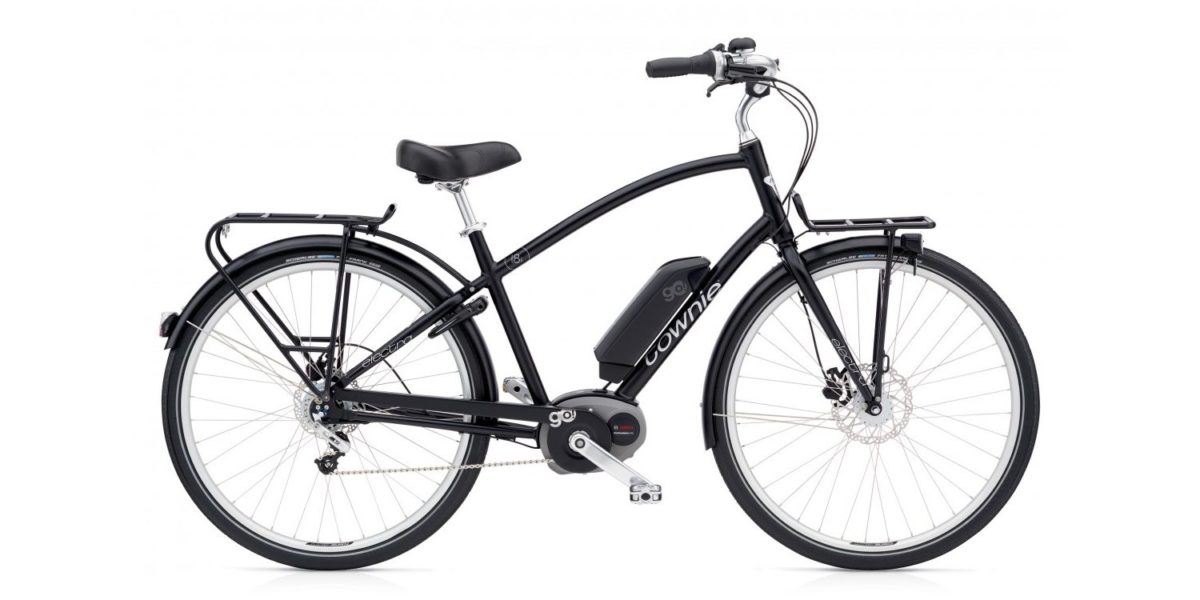




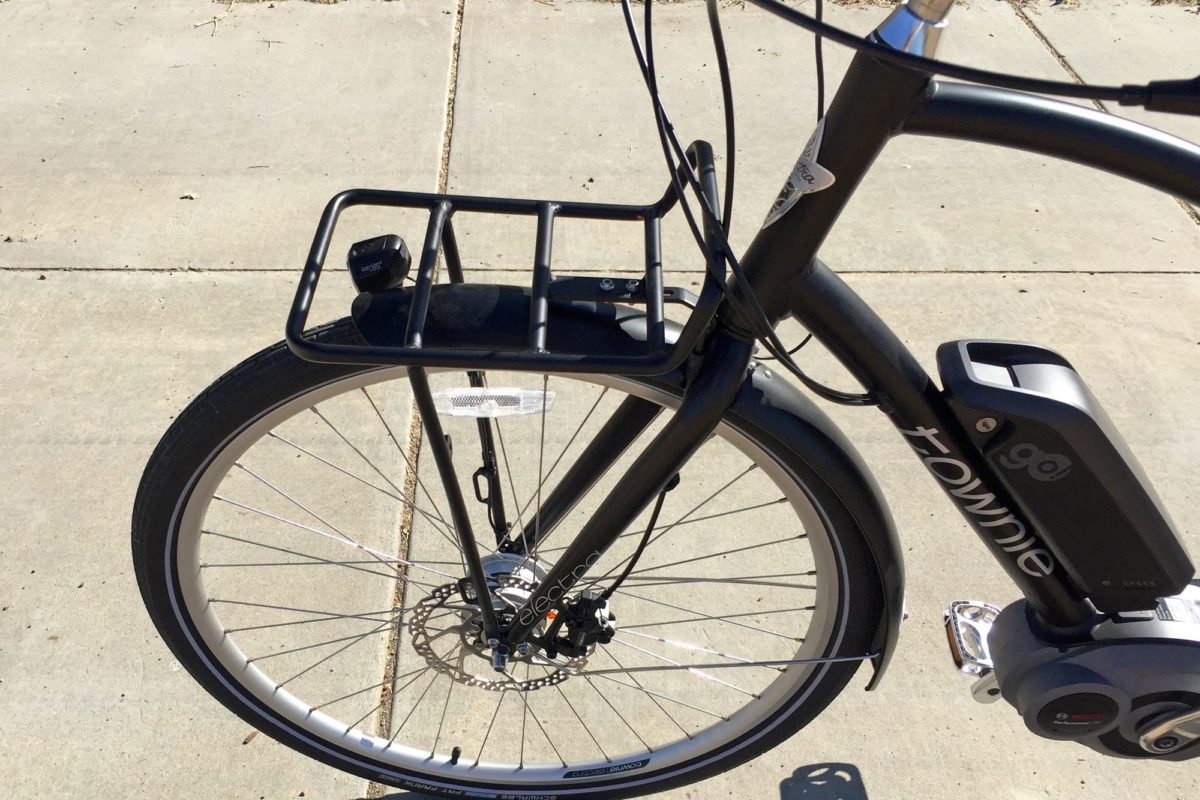

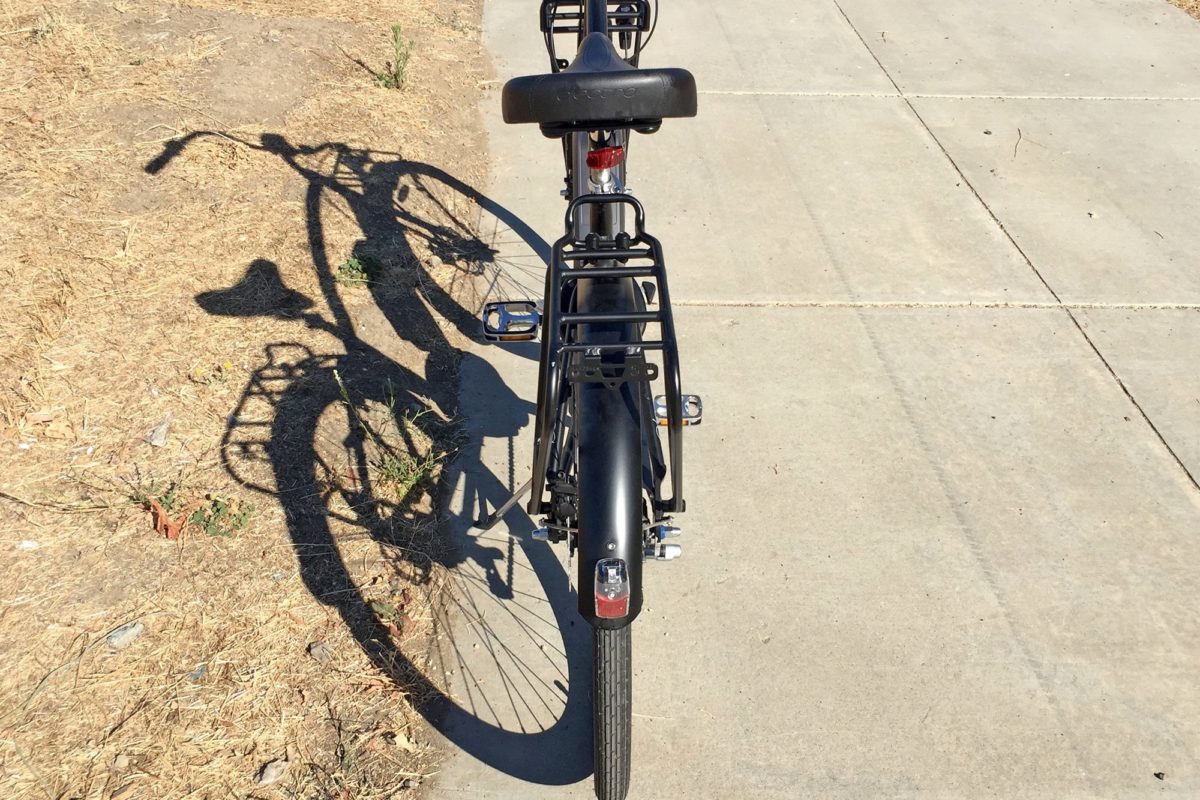
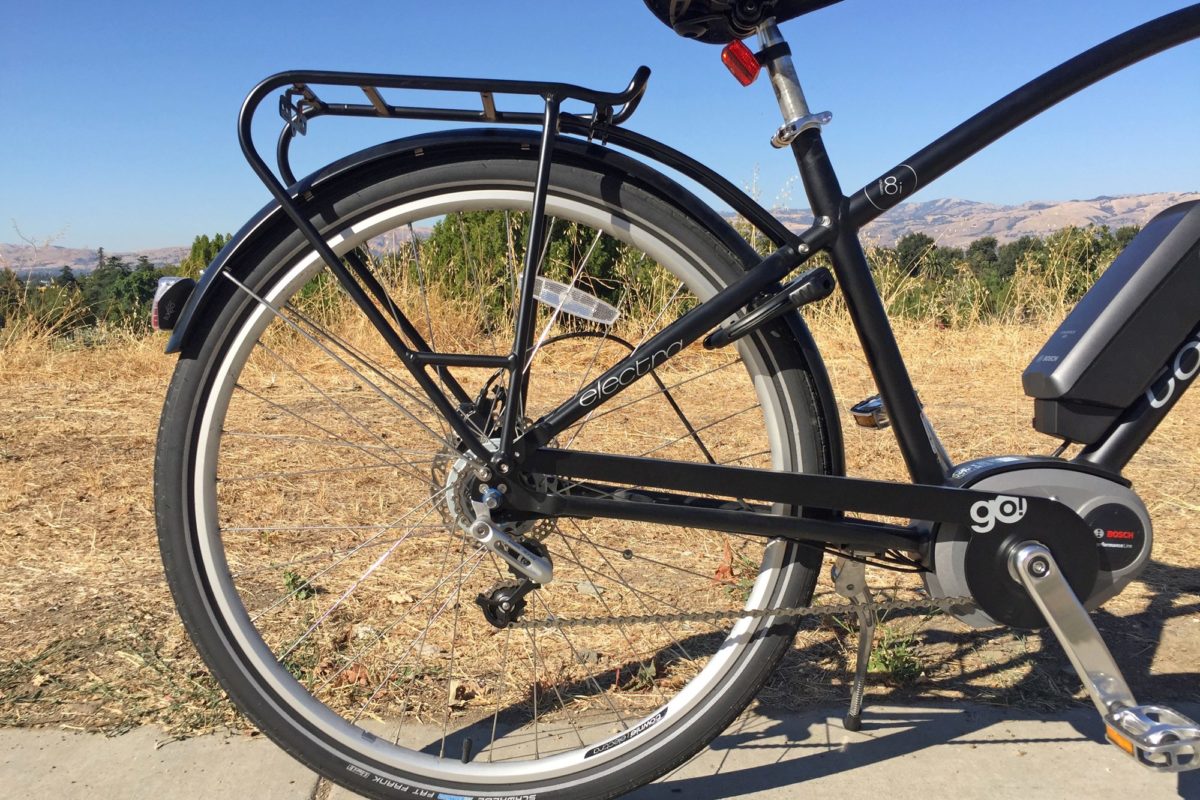

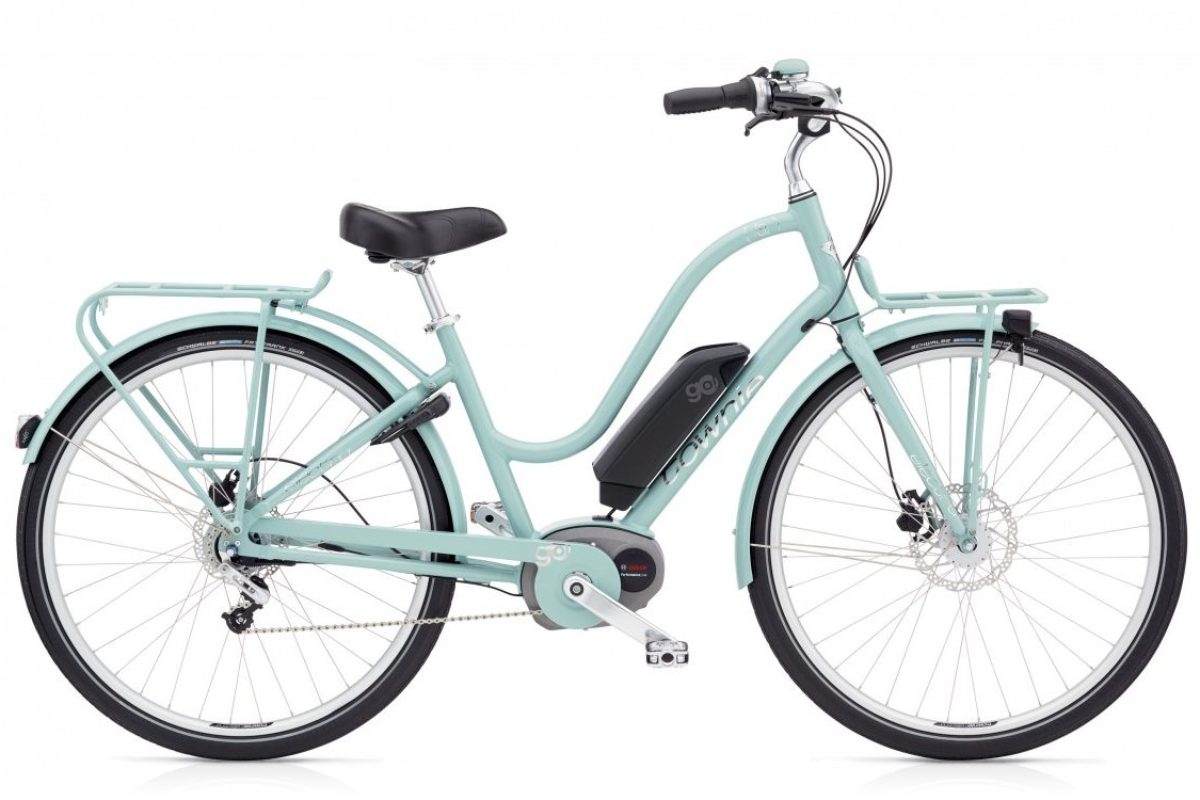
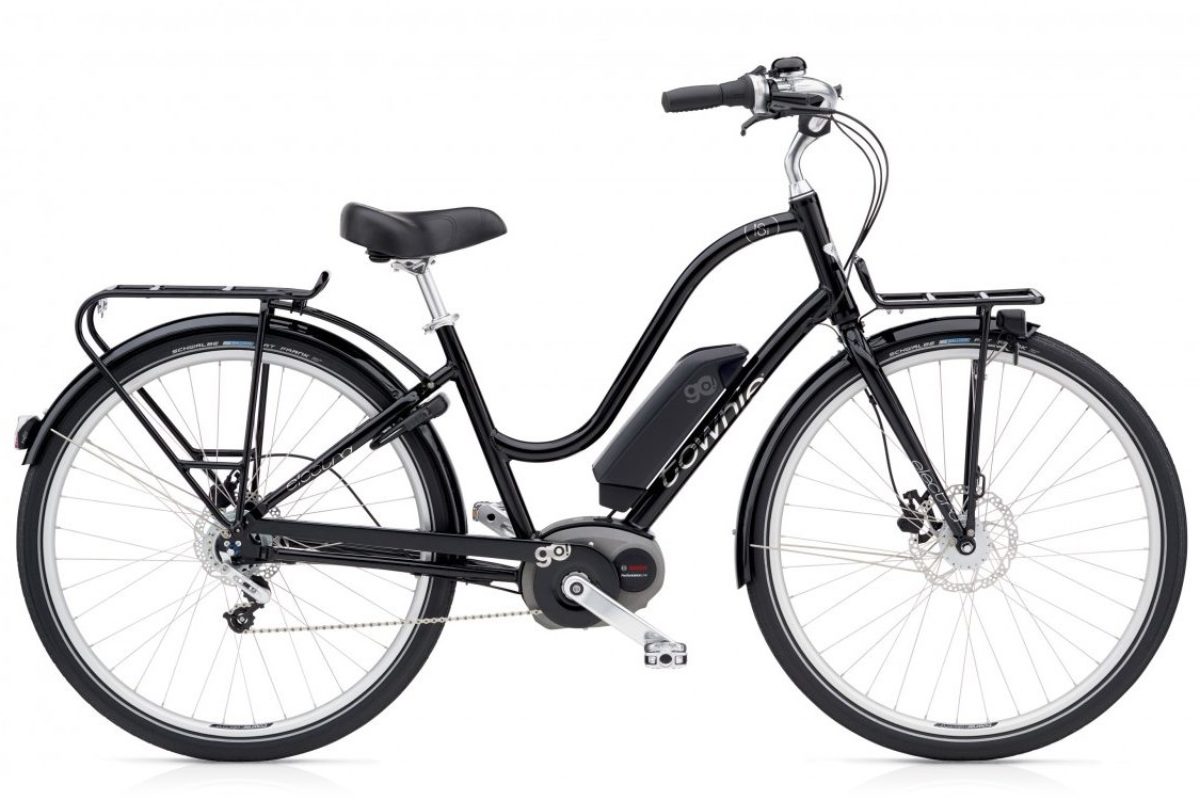
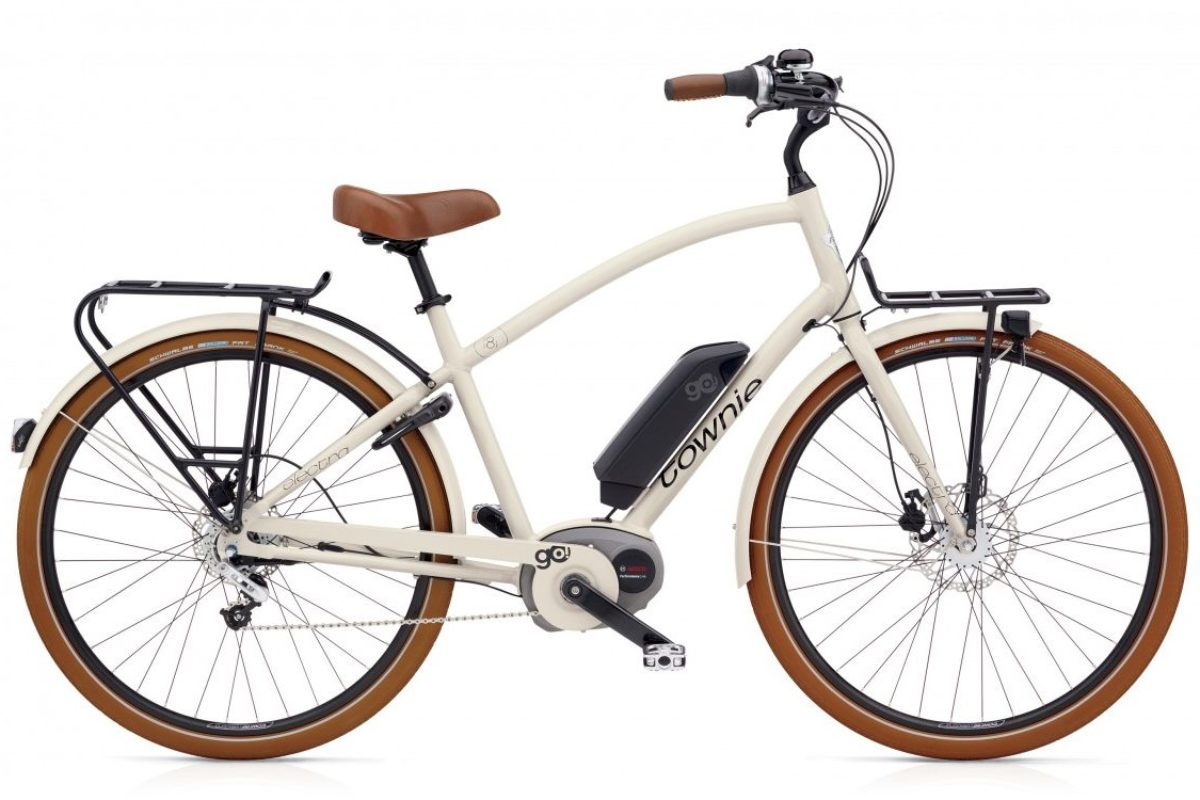
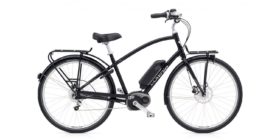
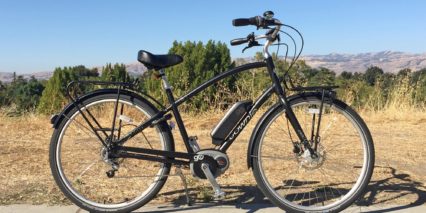
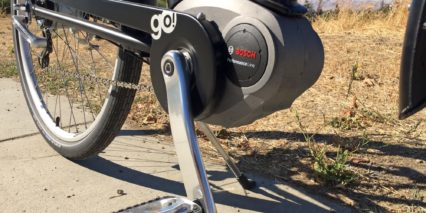

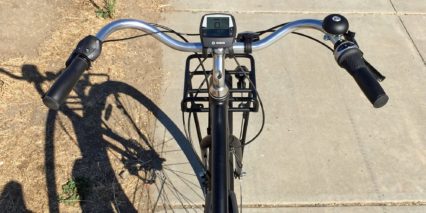
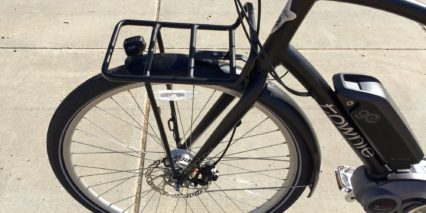
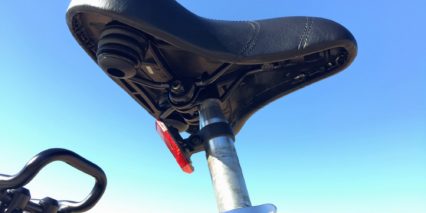
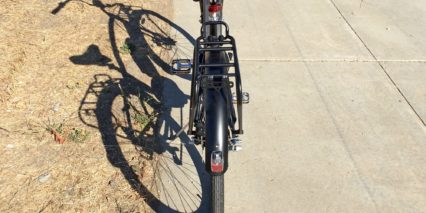
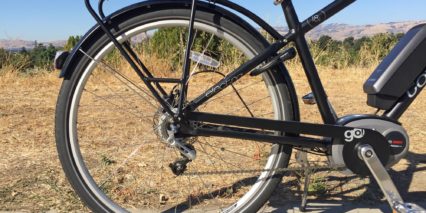
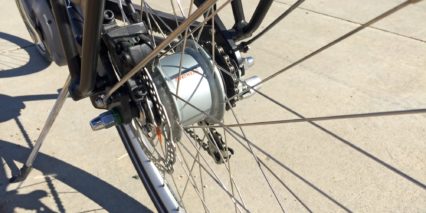
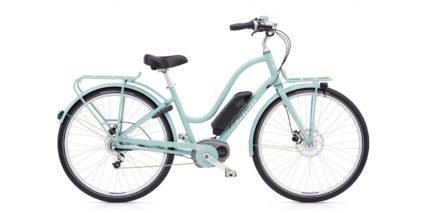
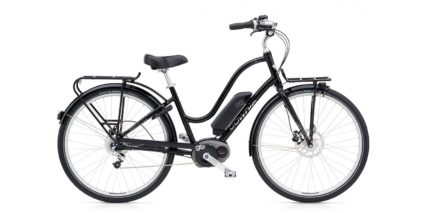
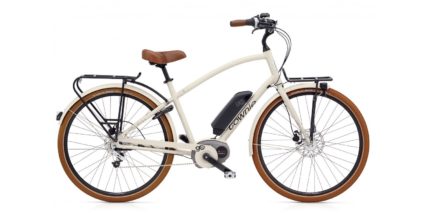

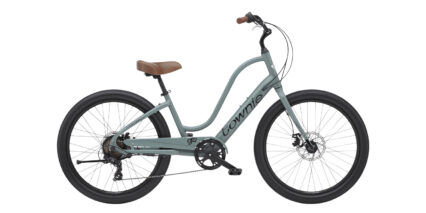
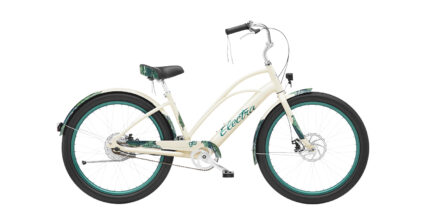
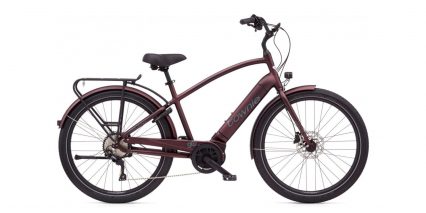
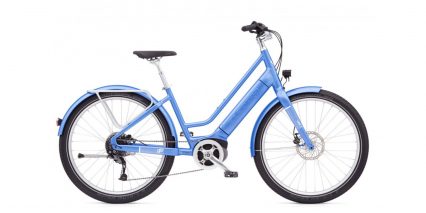
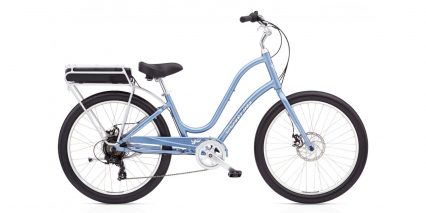
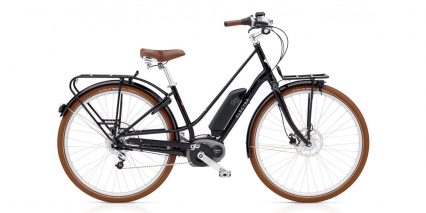
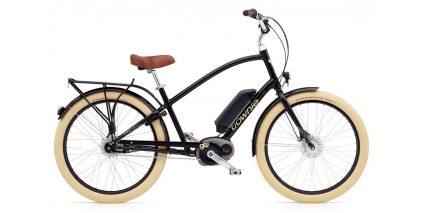
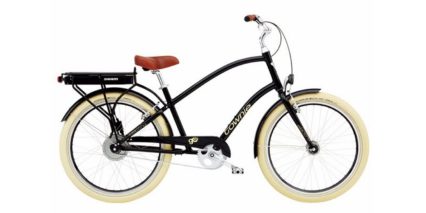
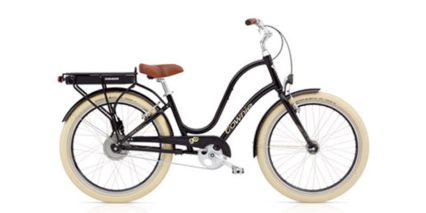
John
7 years agoI got my Electra Townie Go Commute about 6 weeks ago. It does not have a front dynamo and the front wheel has quick releases. I love the ride and my only complaint is that they did not key the battery and the cafe lock together. I have to carry three keys, including my chain lock, with me when I ride.
ReplyCourt Rye
7 years agoHuh, that’s very interesting… Thanks for chiming in about the dynamo and quick release front wheel. I wonder if the bikes I saw were from a different batch or had different requirements or something? Would you mind sharing which state you bought yours in? I conducted this review in Santa Clara, California (near San Francisco).
ReplyJohn Kuecks
7 years agoI bought mine at Santiago Cycling in Tustin, CA, Southern California. Mine is the Stone Grey/White model. I had wanted the Townie Go high step but Santiago Cycling stated their supplier, and they are a Trek shop, was all out of Townie e-bikes except for the Commute, so that’s what I bought. It sounded like they might have more in September.
ReplyCourt Rye
7 years agoThanks for the update John! That’s interesting, I hope you enjoy the Commute :)
ReplyPapa G
6 years agoI posted this in response to a reply to my comments on the Trek Super Commuter +7 forum. Since it pertains to the Electra Townie Commute 8i, I thought I would repost it here. Thanks Court, your reviews helped my wife decide on this ebike. She loves her new white step through 2018 Electra Townie Commute 8i. We have been riding together for the past 12 years on carbon fiber road bikes, with the associated clothing, clipless pedals and etc.. For the past several years she would dread climbing the 12% grade hill leading up to our home from the American River Bike Trail at the end of a ride, especially if the ride was more than 15 miles. She now loves to go out and ride the ebike, and that 12% hill, no problem. Her Townie Commute is a relaxed geometry step through ebike with a comfortable saddle that she can ride in casual clothing. With both my Trek SC +7 and her Townie Commute being class 1 (with pedal assist up to 20mph), we can ride together, at the same pace (the Townie Commute 8i has the same Bosch Performance Line Cruise 63 NM motor, with a 400 watt battery (the SC +7 has the 500 watt battery), and the batteries are interchangeable between both ebikes). We added both a Niterider LED headlight and Solas taillight to her ebike as well. It’s been hot this summer in Sacramento, California, so we have been taking evening rides of 15 miles in the last hour of daylight, when it is cooler. We added a cadence sensor and attached her Garmin 520, we added a handle bar mount water bottle cage and we added the Electra rear wicker baskets, so we can ride about 10 miles each way on the American River Bike Trail to the Historic Folsom Farmers Market on Saturday mornings to buy fruits and veggies. She is loving it. We are both in our mid 60’s and this investment has been a game changer for both of us.
Replycourt
6 years agoThat’s a beautiful story, Papa G! Thanks for re-posting it here on the Electra review. I’m sure others will appreciate it. Great tips on those accessories, hope the bikes continue to bring happiness and health to you both. Chime in anytime with updates ;)
ReplyPapa G
6 years agoThanks Court. In case anyone was interested, here is the link to the handlbar water bottle cage mount on the official Electra website.
Boggy
5 years agoI recently purchased this model for commuting 20 miles to work (one way). The front wheel came with quick release and no dynamo front hub, also the included kickstand was of the double-legged center variety that regular Townie has. I just wanted to mention that the included ABUS 5650 frame lock does have a port for optional cable or chain accessory, see the photo here.
ReplyCourt
5 years agoThanks for the update Boggy, and sharing a photo. It sounds like you’re getting great use out of the bike, hope it continues to work well for you! Chime in anytime with more feedback. I hope to review the 2019 Electra models at some point in the coming months :)
ReplyBoggy
5 years agoAlso, in your video you went over the clicking noise Shimano Nexus 8 speed hub was making, you thought it was because it was protecting itself from too much torque applied. Well, my bike was making the same clicking noise, and easing on the torque did not fix this issue with certain speed selection (mainly 5th speed). There’s very short video that shows how to properly calibrate this hub very quickly without using any tools, once I did that I no longer encountered any clicking, it’s perfect. This is the video link.
Dj
4 years agoHey Court,
I think I bought the last townie go commute 8di left in the world. Haha. it was on sale so I jumped on the price. My bike, like the others came with a quick release front tire and no front dynamo hub and a two legged middle kick stand. I actually bought it at another summit bicycle store in San Jose.
I usually bike with the family around the neighborhood and don’t use it as a commuter. I wanted a cruiser style frame, that’s why I chose this bike. IMO the downsize is the weight of the bike, but I deal with it. I’m still trying to find a rack that can hold this bike with the long front fender. So far it’s only the Thule easy fold, but it’s super expensive. But might be the only rack that solves this issue. Unless I decide to just remove the front rack all together, then problem solved. (which I might do since I never use it and I will just mount the light to the frame).
The frame is pretty tall. I’m 6’1” and I tip toe when stopped. The reason is, I want full leg extension when I ride so my seat is higher but then it’s not as easy to stand with my feet flat for the ‘flatfoot technology’ of the bike. Overall I’m happy with the bike. The price point and style is what I wanted, so it worked out. I’m sure 2019, 2020 models are far more advanced in technology and style, but I couldn’t drop that sort of money. Love your site and videos.
ReplyCourt
4 years agoHey Dj, glad you found a great deal and are working out the details with the rack. Yeah, I review a bunch of different types of ebikes and usually have to spend some time figuring out how to mount them on my car rack. A crossbar adapter is a great option, and removing the fender or front rack on the bike is another possibility. This stuff definitely adds up… I hope your bike works well for many years and appreciate your encouragement regarding EBR :D
ReplyIsaac
2 years agoI purchased this bike back in 2020 and have racked over 4000km (2400miles) commuting to work. Mine also had no dyno on the front hub with a quick release and center double prong kickstand. Also mine has Tecktro Vela brakes. Quality issues I’ve encountered are that the front fork started rusting, and the kickstand doesn’t retract as smoothly. Both have been replaced under warranty. Also note that the original chain may have been a 10-speed chain. My local shop insisted it was a single speed chain as listed by Trek. The single speed chain is too wide and will scrape the sides of the chain tensioner. They settled on a 9-speed chain as spec’d by the Shimano chain tensioner.
ReplyCourt
2 years agoGreat feedback Isaac, thanks for sharing your feedback about the bike and what has held up! I’m glad you were able to figure out the chain with some help from your local shop.
ReplyLaurie
2 years agoI test rode many eBikes last summer and purchasing the Townie Go. I am 5’ 9”, with very long legs and arms (33”), which is a challenge. I thought the Townie was the perfect bike for me and I road over 3,000 km (1,864 Miles) without causing endless shoulder and back issues.
I live in Victoria, BC and I bike up many steep hills. I had continual problems with the chain coming off and jamming between the motor and chainring. Once jammed in this area, the bike could not even move. So, after many visits to the shop they felt the chain system was not good for really steep hills. With no support from Electra my guys changed out my chain and gear system to a mountain bike system and the seemed to really help and they covered the costs. Now I am really struggling with bigger hills in my Ebike group. I can’t ride this bike like my road bike or Specialized commuter bike up hills and it is really challenging as I can’t push down or add pressure on the pedals to climb.
I am very frustrated with this bike decision for my needs. I am on gravel quite a lot and on hills and have had two crashes over in the last 5 weeks which I feel are due to the slick tires on gravel trails. I need to consider a new bike before I really hurt myself. I need a comfortable ride, that can go up hills and starting my search all over again. I am about to test drive the Cube from a friend, but of course the shops are low in inventory everywhere.
I LOVE this site and have shared it with anyone who is considering a new bike, thanks for putting it all together. Do you have bike suggestions for me?
ReplyCourt
2 years agoHi Laurie, it sounds like you have been through a lot! I can relate to the chain issues you’ve expressed, as I have had similar issues on a range of bikes during my years creating reviews here. I’m glad the shop was able to help you, but yes… it sounds like the new drivetrain has made climbing more difficult. I have also crashed while riding on gravel, and even hit my chin on the ground pretty hard once. While the knobby tires can help reduce slide, the heavier weight of ebikes and higher speeds they tend to support can still elevate this kind of risk.
Yeah, many electric bikes are out of stock right now. It’s difficult to point something out when the pool of options is limited (and unknown to me at this point). I think Cit-E-Cycles has a shop out by you, and they do have several good brands to consider. I think Electra is great, and would probably consider keeping that bike and learning ways to adapt to its limitations such as being extra careful on gravel. Perhaps you could get a smaller chainring to make climbing easier, or a wider range of gears on the cassette? I’m pretty price sensitive, so exploring brand new bikes that might have other trade offs (such as ergonomics, you mentioned your back and shoulders have been okay with the upright cruiser style from Electra). I hope these considerations help guide you, but mainly I’m just sorry to hear you’ve had some struggles lately, that’s no fun. At least the weather has been getting nice here in BC! I love Victoria and hope to visit again soon :D
ReplyLaurie
2 years agoThanks for your input, believe it or not I was going very slow in both accidents, just weird situations. I was able to determine, after watching your reviews and test driving a friends bike, I need the Specialized Turbo Como, size Large and step through. Now, I have to probably wait for years, lol. Nothing left here in Victoria and I have tried a few spots in Vancouver, so watching used sites. I just wish this industry would start painting bikes in brighter colours for safety, 80% of options are dark colours.
We have a small EBike Meet up group here in Victoria, come join one of our rides.
Laurie
2 years agoThanks for the shop lead Court, I will give them a call. The club was set up by a lovely women who used to work in a local E-Bike shop, linked here. It’s within the MeetUp on-line site. Connect with her if you want to come join us.
ReplyCourt
2 years agoCool! I just requested to join, thanks so much Laurie. Perhaps we will cross paths on a ride someday :D
ReplyLaurie
2 years agoThanks for hooking me up with Norm at Caps Electric Bike in Port Moody. I am heading over on Wednesday to pick up my new “Cherry Red” beauty. You rock Court, thanks so much.
ReplyCourt
2 years agoAwesome!! I’m so excited for you Laurie, happy to hear that Norm took good care of you and I hope the bike works out great :)
Reply